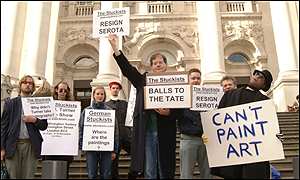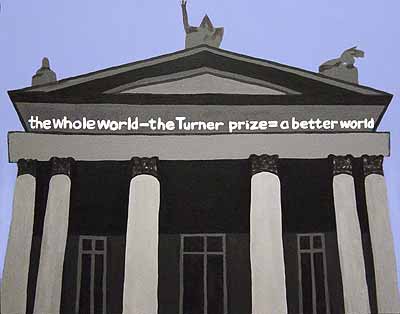|
TURNER
PRIZE DEMO 2001
6 November 2001 at the press launch and 9 December 2001 on prize day LIGHTS GOING ON AND OFF There was a plain-clothes Stuckist demo on 6 Nov 2001 at the Press Launch of the Turner Prize at Tate Britain, and a Stuckist demo in clown costume on 9 Dec 2001 on the prize-giving day.
"In
certain respects the Turner Prize never changes: art fleetingly makes
the front pages; the dreary Stuckists protest outside the Tate and
the winner gets a cheque for 20 grand."
The clown demo featured a cardboard cut-out of Tracey Emin. In the evening, the Stuckists created their own Turner piece of art by flashing torches on and off. The Turner winner was Martin Creed, who turned a light on and off. PRESS The clown demo was syndicated for worldwide TV coverage to over 400 stations by Reuters. Regan Tamanui of the Melbourne Stuckists writes: "I woke up this morning & turned on the news & saw you guys protesting. It was really cool." Michel Castaignet of Marseille Stuckists: "It was also broadcasted in France at the noon and evening news on First Channel." "As
has become the custom in recent years, the Stuckists, a group of traditional
artists opposed to Sir Nicholas Serota and the Turner prize, were
vicious in their criticism. Charles Thomson, the Stuckists' leader,
said: 'The Turner prize is a national joke. It promotes mindless conformist
novelty and gimmick at the expense of real values. It's out of touch
with society, life and the majority of artists.' "Yesterday, they
picketed the awards ceremony when it was broadcast live by Channel
4, with some members dressed as clowns to protest at what they call
the Tate's "media circus". They named Sir Nicholas the Art Clown of
the Year and said they would be inviting him to buy a custard pie
and push it into his own face." "Outside,
a group of artists known as The Stuckists, who campaign for traditional
artistry, staged a protest. As guests arrived for the evening affair,
they mocked Mr Creed’s work by flashing torches on and off and called
for the resignation of the Tate’s director, Sir Nicholas Serota. Charles
Thomson, a co-founder of The Stuckists, said: “It has gone beyond
a joke . . . the only people who cannot see how ridiculous this whole
thing is are the organisers themselves.” Mr Thomson said Mr Creed’s
work exuded “outstanding stupidity”." "Creed's
The Lights Going On and Off, an empty room in which the lights do
just that, is the most minimal work ever to win the £20,000 prize,
so minimal in fact that many of those who have seen it were unaware
it was anything more than dodgy wiring. But the judges, who included
the Tate supremo Sir Nicholas Serota, loved it for its daring and
for driving some traditionalists to apoplexy. Last night a group of
Stuckists - angry at the way painters have been sidelined by the prize
- rose to the bait and gathered outside flashing their torches on
and off in protest." "But
dissent against the judges' choice has already begun, after a group
of traditionalists called The Stuckists protested outside the Tate.
They made their feelings known with their own makeshift, modernist
masterpiece - flashing handheld torches on and off. The group's founder,
Charles Thomson, said: "This has gone beyond a joke. The only people
who cannot see how ridiculous it is are the organisers themselves." Ekow Eshun said in Shock Tactics on the BBC site, "if scandal equated directly to success then this year's winners should probably be the Stuckists, the ragged band of artist malcontents who've turned their annual placard-waving anti-Turner protest outside the Tate into a kind of art event of their own that now generates press attention from around the world." Turner Prize 2001 in Pictures on BBC News Online shows the nominees and the Stuckist demo. The demo was reported in The New York Times (14.12.01). Stuckist view on Martin Creed in the Turner Prize cited in Arizona Journal of International & Comparative Law, Vol. 24, No. 2, 2007. See note 5 here (pdf). A photo of the demo was included in an article by Caroline Rossiter in The Faster Times (6.12.09). A photo of the demo was included in Jonathan Jones' Guardian blog (25.11.10).
ART CLOWN OF THE YEAR 2001 The Art Clown of the Year Award 2001 was won by Sir Nicholas Serota. Other nominees were Charles Saatchi (last year's winner), Norman Rosenthal and Sarah Kent.  JACQUELINE'S
EGGS JACQUELINE'S
EGGS
Jacqueline Crofton got in the news and the Tate's bad books by throwing an egg at the wall of Martin Creed's non-exhibit. She was nothing to do with the Stuckists, although she was invited to show, and did so, in the Stuckism International Gallery's first show in July 2002. RACHEL'S PAINTING
|
|||

.jpg)
